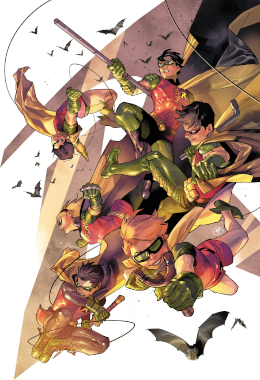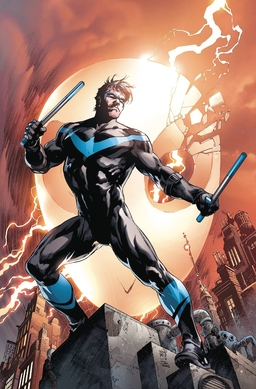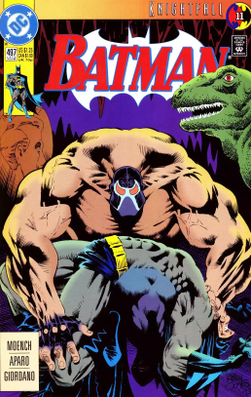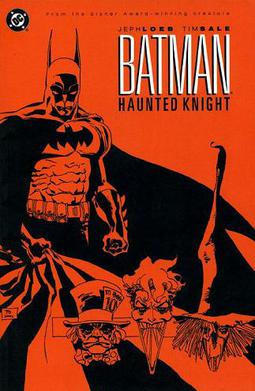Related Research Articles

Robin is the alias of several superheroes appearing in American comic books published by DC Comics. The character was originally created by Bob Kane, Bill Finger, and Jerry Robinson, to serve as a junior counterpart and the sidekick to the superhero Batman. As a team, Batman and Robin have commonly been referred to as the Caped Crusaders and the Dynamic Duo. The character's first incarnation, Dick Grayson, debuted in Detective Comics #38. Conceived as a way to attract young readership, Robin garnered overwhelmingly positive critical reception, doubling the sales of the Batman titles. Robin's early adventures included Star Spangled Comics #65–130 (1947–1952), the character's first solo feature. He made regular appearances in Batman-related comic books and other DC Comics publications from 1940 through the early 1980s, until the character set aside the Robin identity and became the independent superhero Nightwing.

Nightwing is the name of several superheroes appearing in American comic books published by DC Comics. The most prominent is Dick Grayson, who takes the name when he leaves his role as Batman's partner and sidekick Robin in his adulthood.

DickGrayson is a superhero appearing in American comic books published by DC Comics, commonly in association with Batman, Teen Titans and Justice League. Created by writer Bill Finger and artist Bob Kane, he first appeared in Detective Comics #38 in April 1940 as the original and most popular incarnation of Robin, Batman's crime-fighting partner. In Tales of the Teen Titans #44, the character, after becoming a young adult, retires his role as Robin and assumes the superhero persona of Nightwing. Grayson has donned the cape and cowl to replace Bruce Wayne as Batman. His most notable spell as Batman follows Bruce Wayne's supposed death in Final Crisis, and sees Grayson adopt Damian Wayne as his Robin.
The Mad Hatter is a supervillain appearing in comic books published by DC Comics, commonly as an adversary of the superhero Batman. He is modeled after the Hatter from Lewis Carroll's novel Alice's Adventures in Wonderland, a character often called the "Mad Hatter" in adaptations of Carroll. A scientist who invents and uses technological mind control devices to influence and manipulate the minds of his victims, the Mad Hatter is one of Batman's most enduring enemies and belongs to the collective of adversaries that make up Batman's rogues gallery.

Jason Peter Todd is a character appearing in American comic books published by DC Comics. First appearing in Batman #357 in March 1983, he was created to succeed Dick Grayson as Robin, Batman's partner and sidekick. He initially shared a similar origin to Grayson, being the son of circus acrobats who are killed by criminals in Gotham and adopted by Bruce Wayne/Batman as his son and protege. Following the Crisis on Infinite Earths event and the rebooting of DC's main comics universe, Jason's origin was changed to being a pre-teen street urchin and petty thief who Bruce adopted and took under his wing after finding the boy attempting to steel the tires off of the Batmobile. This origin has since become the standard for subsequent iterations of the character.

"Knightfall" is a 1993–1994 Batman story arc published by DC Comics. It consists of a trilogy of storylines that ran from 1993 to 1994, consisting of "Knightfall", "Knightquest", and "KnightsEnd".

Batman: Dark Victory is a 14-part American comic book limited series published by DC Comics, featuring the superhero Batman. The series, which ran from 1999 until 2000, was written by Jeph Loeb and drawn by Tim Sale, and it serves as a sequel to Batman: The Long Halloween. Batman: Dark Victory takes place primarily four to five years into Batman's career as a vigilante crimefighter. The plot centers on a series of murders involving Gotham City police officers by a mysterious serial killer only known as the Hangman. Central to the storyline is a territory war between Two-Face and the remnants of the Falcone mob, led by Sofia Falcone.
Shrike is the name of multiple fictional characters appearing in American comic books published by DC Comics.

In addition to DC Comics books, the superhero Robin also appears in other media, such as films, television and radio. Dick Grayson, Jason Todd, Tim Drake, Stephanie Brown, and Damian Wayne are examples of the characters who use the name Robin.

Robin of Earth-Two is an alternate version of the superhero Robin, who appears in American comic books published by DC Comics. The character was introduced after DC Comics created Earth-Two, a parallel world that was retroactively established as the home of characters which had been published in the Golden Age of comic books. This allowed creators to publish comic books taking place in current continuity while being able to disregard Golden Age stories featuring Robin, solving an incongruity, as Robin had been published as a single ongoing incarnation since inception. Unlike his main counterpart, Robin is the only alter ego of Dick Grayson, who uses the title into adulthood, rather than taking on later codenames such as Nightwing or Batman. In addition, the name "Robin" is not taken on by later characters.
Originally created in 1967, the fictional comic book character Barbara Gordon has been adapted into various other forms of media. The character has appeared in both live action and animated television series and films, as well as in video games in her alter-egos as both Batgirl and Oracle!.
"Enter Batgirl, Exit Penguin" is the first episode of Season 3 of the Batman television series, first aired on ABC September 14, 1967 as its ninety-fifth episode. It guest starred Burgess Meredith as The Penguin, and also was the first appearance of Yvonne Craig as Police Commissioner Gordon's daughter, Barbara Gordon, a.k.a. Batgirl.

Batman and Robin is an American comic book ongoing series, created by Grant Morrison and featuring Batman and Robin. The debut of the series followed the events of "Batman R.I.P.", Final Crisis, and "Battle for the Cowl" in which the original Batman, Bruce Wayne, apparently died at the hands of DC Comics villain Darkseid and features the winner of the "Battle for the Cowl" as the new Batman. The conclusion of Battle for the Cowl shows Dick Grayson ascending to the role of Batman, while Damian Wayne becomes the new Robin.
This article is about the publication history of the DC Comics fictional character Dick Grayson, who has been portrayed in comic books alternatively as Robin, Nightwing, and Batman.

Batman: Haunted Knight is an anthology trade paperback published by DC Comics in 1996. It reprinted three one-shot specials from the previous three years. Each of the stories was written by Jeph Loeb and featured art by Tim Sale. The popularity of these three stories led to the three miniseries Batman: The Long Halloween #1-13, Batman: Dark Victory #0-13 and Catwoman: When in Rome #1-6.

Batman Beyond is a comic book series featuring the fictional character Terry McGinnis as Batman and based on the animated television series of the same name. It has appeared in various DC Comics publications, including a six-issue miniseries from 1999, a 24-issue series running from 1999 to 2001, the "Hush" arc by DC Comics in 2010, and an eight-issue miniseries in 2011. A short-running series titled Batman Beyond Unlimited was later released, followed by Batman Beyond 2.0 in 2013.

The Court of Owls is a criminal organization and secret society appearing in American comic books published by DC Comics. They appear as adversaries of the superhero Batman. Created by writer Scott Snyder and artist Greg Capullo, the Court is described as an organization of the wealthiest and most influential citizens of the city of Gotham, having existed since the city's founding and completely unknown among its general population outside of an urban legend centered around their reputation for grisly assassinations carried out by indoctrinated agents known as Talons. The 2015–2016 "Robin War" story line details their international expansion, with the group renaming itself the Parliament of Owls.

Batman/Teenage Mutant Ninja Turtles Adventures is a six-issue intercompany crossover comic book miniseries featuring fictional heroes Batman and the Teenage Mutant Ninja Turtles. The miniseries is based on a previous intercompany crossover titled Batman/Teenage Mutant Ninja Turtles between DC Comics and IDW Publishing, which was first announced during IDW's panel at the 2015 San Diego Comic-Con and released as a six-part monthly miniseries in late 2015 and early 2016.
References
- ↑ Review:Robin:Year One trade paperback (DC Comics), Collected Editions, July 27, 2005.
- ↑ Robin:Year One #2 Archived 2016-03-03 at the Wayback Machine , Craig Lemon, Comics Bulletin, December 3, 2006